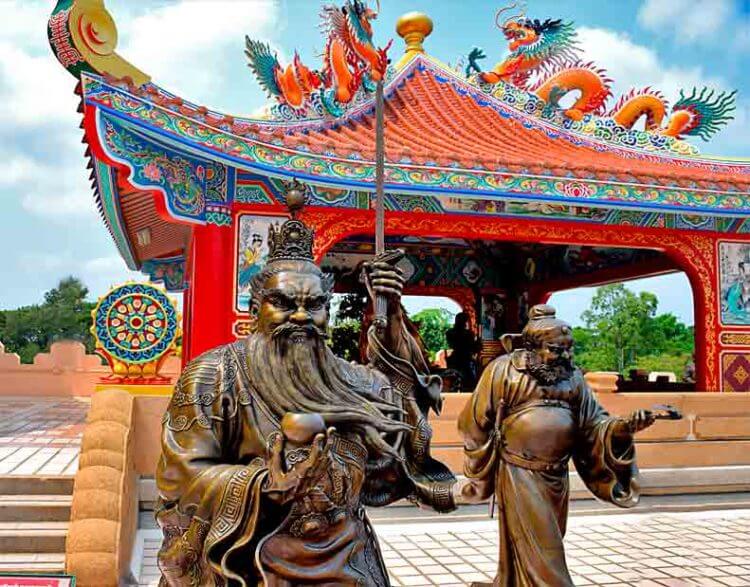The development of Chinese medicine
The second half of the second century saw the further development of Chinese medicine, particularly the medical directorates at the imperial courts. They now numbered 317 specialists, including 293 physicians of all major specialties, including perhaps the only woman physician in China, Chun Yu-yan, an obstetrician-gynecologist.
Medical Administration
Composing its staff from among the best physicians through selection at special examinations, this medical department not only served the emperor and his cronies, but also carried out some work to test the knowledge and establish qualification categories of people's doctors.
To some extent, it also exercised control over their activities in the largest cities. It also edited the most important medical books. And this work was especially important at that time and here is why: In 105 Cai Lun from rags and tree bark received a material that was destined to remain irreplaceable to our days.
The invention of paper
The Chinese scientist gave paper to mankind (Tso-chen - "paper made of bamboo" and Mu-chen - "paper made of wood" were already in use in the 4th century B.C. And, approximately in the 1st century B.C. Hashi - "paper made of silk" was invented. For this purpose, the cocoons of the silkworm were turned into a fibrous mass, which was then molded into a thin sheet.
But silk paper (hashi) was certainly too expensive to become widely available. In his search for a cheaper material to make it, Tsai Lun settled on another raw material of fibrous structure.
During his first attempts to find a substitute for hashi, he used tree bark, rags and old fishing nets. In 105 AD he managed to create "Tsai hao-chzhi" - "Tsai official's paper" - exactly what has traveled around the world in almost unchanged form and has survived to this day.
This discovery was truly revolutionary for the development of culture. The book made of paper became a medium of progress available to the general public. Chinese medicine also owed much of its further development to the book.
The Three Kingdoms Period
During the period of the Three Kingdoms period, (more information: Doctors of Chinese Medicine) there were continuous wars between the principalities of Wei, Shu and Wu. Frequent invasions of the Huns in some 60 years plunged the country into a state of deep economic decline.
Irrigation facilities were destroyed, fields became desolate, many cities were burned and looted, and traditional trade relations were broken. All this affected the state of medicine, which, moreover, soon came under the strong influence of Buddhism. Buddhist monks appeared in China before the beginning of our era and in its first centuries. They also brought some medical knowledge to China.
Many books by Indian doctors were translated into Chinese.
The role of Buddhism in the development of medicine
Such activity is explained by the fact that in the struggle with Taoism, Buddhism sought to attract the masses to its side by developing medical activity. The rivalry for the right to dispose of the soul of the believer resulted in the rivalry for the "expulsion of diseases" from his body.
Medical theories of Buddhism
In contrast to the national Chinese doctrine of the two opposing principles of "yin" and "yang" (more information: Theories of Chinese Medicine) and the five primary elements - "Wu-hsing", Buddhism based its medical theories on the doctrine of the "four big ones", according to which the world consists of four basic substances - earth, water, fire and wind.
Their correlation and interaction explained the state of the human body: the balance of the "four big ones" determined the state of health, and its violation caused disease. Thus possible deviations of one of four "big" entailed 101 diseases, that in total gave the number 404.
Authors of medical books
Looking ahead, let us say that this number was subsequently summarized by the data of some authors of medical books.
Tao Hup-jin
Tao Hup-jin, compiled a book "404 Prescriptions" in 500 year.
Sun Sy-miao
Sun Shi-miao followed the same path (Sun Shi-miao, a physician who lived in the late 6th and early 7th centuries, is known for his classic descriptions of diseases such as hemeralopia, beri-beri and rickets. He suggested treating "chicken blindness" with preparations of animal liver.
In the book "Valuable recipes" (or "A Thousand Golden Recipes"), which numbered 60 volumes, he described the treatment of many women's and children's diseases, poisoning. A separate chapter is devoted to the method of acupuncture and moxibustion, the author of the book "Valuable recipes", and Wang Tao, the author of the work on diagnosis and therapy of a number of diseases.
Wang Shu-he
Wang Shu-he, who lived during the Three Kingdoms period, created even before the mystical ideas of Buddhism about the perishability of the body and the immortality of the spirit, moving into another shell, were perceived by representatives of Taoism and became widespread. Coming from the family of Emperor Zhou Xian-wang of the Zhou dynasty, Wang Shu-he is known as a major medical official author of a large classical work on the pulse.
Being a deeply and comprehensively educated man for his time, he was well versed in all the data that medicine had at that time in the fields of practice and theory. While serving as a government medical official, Wang Shu-he attached great importance to the prevention of disease and, in particular, fervently defended the view that most diseases of the ruling class were caused by excessive eating.

He also attached great importance to the strengthening of the body, and therefore offered a whole system of measures to harden the body. Wang Shu-he also worked a lot in the field of improving diagnostic methods, in particular, methods of pulse research, which served as the basis of a large classic work on "pulse diagnosis", consisting of ten volumes, divided into 98 chapters.
Summarizing in this work all that was known before him about the pulse, he contributed many data from personal observations and research. This work, which appeared in 280 AD and was called "Mei-ting", in subsequent periods, served as a source for the transfer of the doctrine of the pulse to other states, in particular, in 541 AD - to Korea, in 562 AD - to Japan.
In the XI century, the famous Abu Ali ibn Sina used this work in the study of pulse varieties and included data from it in his famous "Canon of Medical Science".
Of the 48 types of pulse described by him, 35 are mentioned in the works of Chinese authors, and Avicenna borrowed them from there. Information about the pulse penetrated from China to India, where the first references to the nature of the pulse, the role of "pulse diagnosis" appear in the 8th century in the medical books Shaengadra. Wang Shu-he's works on the pulse were the initial source for Chinese (and not only Chinese) scientists on this issue.
All of them were based on Wang Shu-he's data, and many of them mainly just developed the ideas presented in "Mei Ting". It is interesting to note that historians highly appreciate the merits of Wang Shu-he in preserving for future generations the famous work of Zhang Zhong-tszin "Shang han lun".
The only copy of this ancient book on febrile diseases was the property of Wang Shu-he, who reproduced it and gave the opportunity to use it to physicians of different provinces, contrary to the then existing custom.
Huang Fu-mi
Another prominent physician of the Three Kingdoms period, Huang Fu-mi, devoted himself to the further development of the original Chinese method of acupuncture and moxibustion treatment. He was born in 215 AD and died in 282 AD. A contemporary of Wang Shu-he, he came, in contrast to the latter, from a poor peasant family living in Lint'e County, Kangshu Province.
He became interested in acupuncture (acupuncture) and moxibustion early in his career and carefully studied and summarized what was known about these therapies before the 3rd century.
A significant stimulus for the study of zhenqiu ("zhenqiu" - this is the pronunciation of the hieroglyphs denoting the method of acupuncture ("zhen") and moxibustion ("qiu"), was some chronic illness of Huang Fu-mi himself, which he treated with methods recommended by Taoist monks; but this treatment only increased suffering, and then Huang, engaged in even more in-depth study of national medicine, and experienced the effect of the method of zhenqiu.
As a result of his careful study of zhenqiu, Huang Fu-mi wrote his famous work on this method called "Tia and Ting". Huang Fu-mi's work "Tia and Ting" was highly appreciated by both his contemporaries and medical practitioners of later generations. "Tia and Ting was the main source of literature in the study of acupuncture and moxibustion, and further research in this field was based on its data.
The book was used in 265 by the Chinese physician Jie Tseng to disseminate the method of acupuncture and moxibustion in Japan. Japanese physicians praised both the work of Huang Fu-mi and this method of therapy itself.
The name Huang Fu-mi was very popular in China, and historians note in the biography of the scientist that Emperor Qing Wu-ti repeatedly invited him to take the position of a medical official at the court, but Huang refused this high honor, remaining to live and work in his village, where he died at the age of 68.
Jin Dynasty
The Jin dynasty, which replaced the Three Kingdoms in 280 AD as a result of the Wei principality's victory over Shu and Wu, was short-lived. Attempts by its founder Sima Yan to strengthen state ownership of land provoked resistance on the part of large feudal lords who were not interested in strict regulation of land allotments, barstools and taxes. China's western neighbors took advantage of the internal strife.
In internecine struggles the principalities often resorted to the help of Huns, Xianbi and Tibetan tribes. In 312 Luoyang, the first capital of the Jin Empire, fell, and five years later the second capital - Chanan. Chinese troops were able to stop the nomads only on the Yangtze River, south of which in 317 the state of Eastern Jin was formed.
In connection with the conquest of the northern provinces by the Xianbi tribes of the Toba, the cultural center of China, beginning in the fourth century, moved from the Huanghe River basin to the basin of the Untszyjiang River.
The great pharmacist and physician Ge Hong
The great pharmacist and medicinal chemist Ge Hong, the founder of medicinal chemistry, lived and worked in its lower reaches.
Ge Hong was born in 281 and died in 341 in Jiang Su County (on the lower reaches of the Yangtze River). Being a very educated man for his time, he began to study medicine with the famous physicians Tseng Yin-she and Bau Shen-she, but then he became interested in the study of herbal and chemical medicinal forms.
Prior to Ge Hong's activities, medicines were mostly only of plant origin, and Ge Hong began to study medicines of mineral origin and also began to make them chemically. Thus he created several chemical preparations of mercury, including mercuric oxide, preparations of copper, iron, lead and so on.
These preparations were tried by the author in medical practice, and on this basis he developed indications and contraindications for their use. Ge Hong wrote two books. One of them is "Tin Kung Fong", which means: "Recipe of the golden safe" (i.e., the most valuable recipes), and the second one is "Tsou Hou Pei Ti Fa" ("Handy remedies to save life in acute and life-threatening cases", or "Handbook of Recipe").
Ge Hong proposed two kinds of drugs for use in surgical practice, "Son" and "Tian", which literally means "to rise" and "to fall". These remedies, which excite and soothe apparently nervous activity, are still in use in the clinic of Chinese medicine at the present day, and their action is highly appreciated.
Ge Hong believed in the limitless power of medicines, but believed that the most effective drugs have not yet been found, and therefore throughout his life created a lot of chemical means in all sorts of combinations. He converted these agents into pill forms and experimented with them, first on animals and then on his patients.
He was thus able to propose many valuable drugs and to gather accurate information about their action. Each of these physicians made a significant contribution to the development of Chinese medicine.


